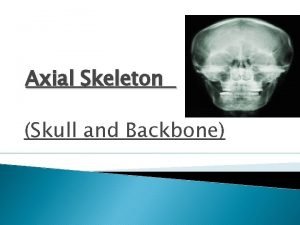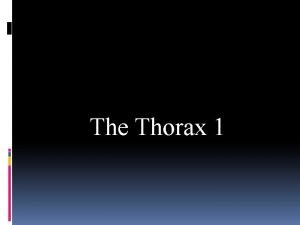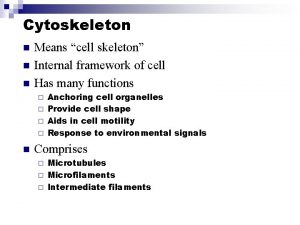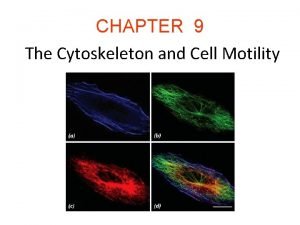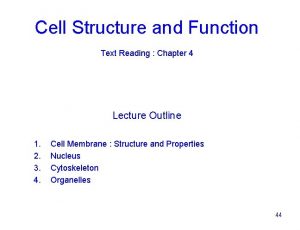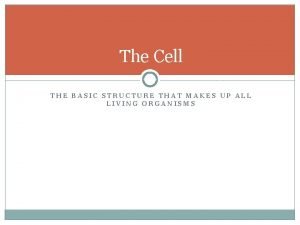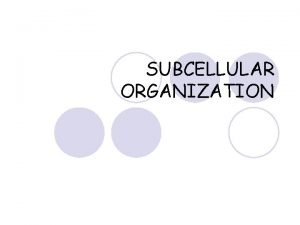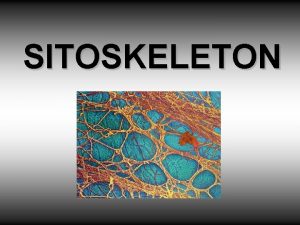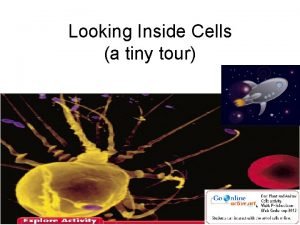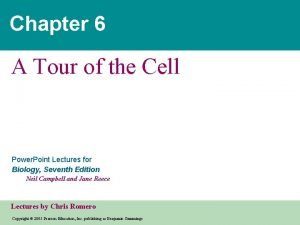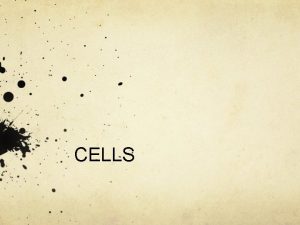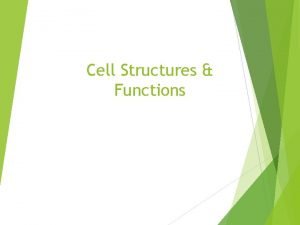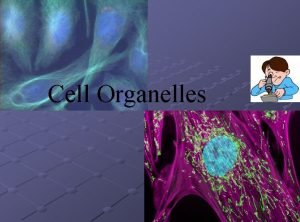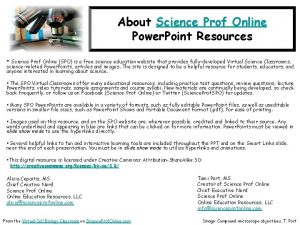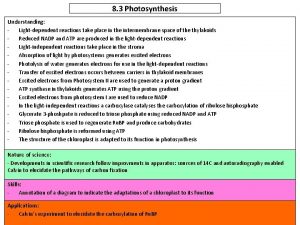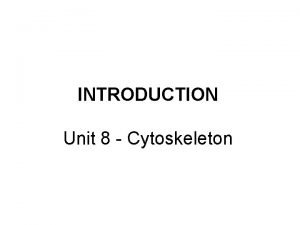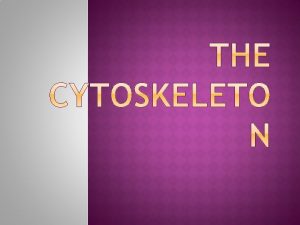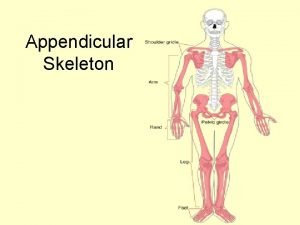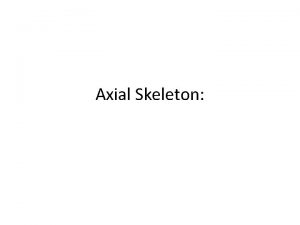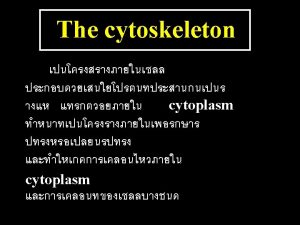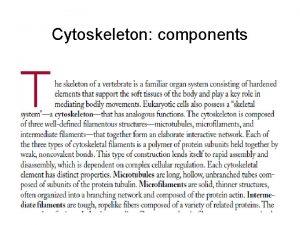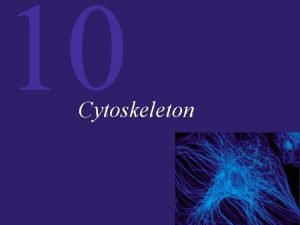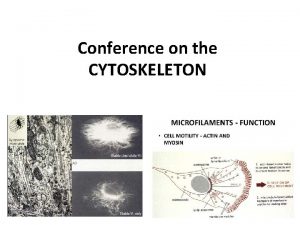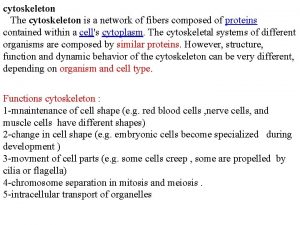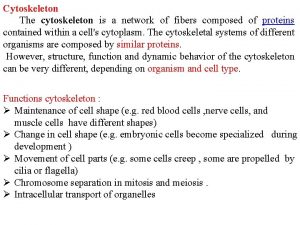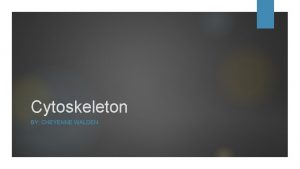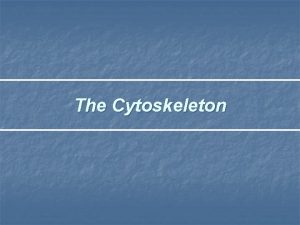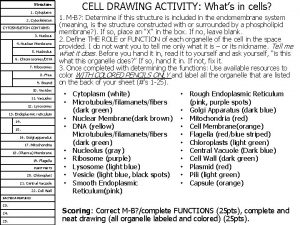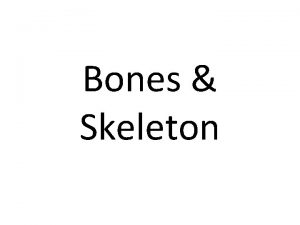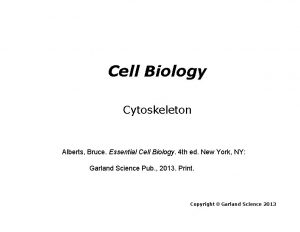Cytoskeleton n Means cell skeleton Internal framework of

















- Slides: 17

Cytoskeleton n Means “cell skeleton” Internal framework of cell Has many functions Anchoring cell organelles ¨ Provide cell shape ¨ Aids in cell motility ¨ Response to environmental signals ¨ n Comprises Microtubules ¨ Microfilaments ¨ Intermediate filaments ¨

Microtubules n Hollow tubes made of the protein tubulin ¨ n n Alternating dimers of a and b tubulin Largest of cytoskeleton filaments Is used for: Maintenance of cell shape ¨ Motility ¨ n ¨ Movement of organelles through cell n ¨ Flagella or cilia Often involves motor molecule Often originate from centrosome

Table 6 -1 a 10 µm Column of tubulin dimers 25 nm Tubulin dimer

Centrioles n n Located in centrosome of animal cells Occur in perpedicular pair Have 9 triplets of microtubules Facilitate microtubule assembly and chromosome separation in some cells

Fig. 6 -22 Centrosome Microtubule Centrioles 0. 25 µm Longitudinal section Microtubules Cross section of one centriole of the other centriole

Flagellum structure n n n Basal body links flagellum or cilia to cell surface ¨ Basal body looks just like a centriole 9 +2 arrangement of microtubules Radial spokes prevent dramatic sliding and only bending

Fig. 6 -24 Outer microtubule doublet 0. 1 µm Dynein proteins Central microtubule Radial spoke Protein crosslinking outer doublets Microtubules Plasma membrane (b) Cross section of cilium Basal body 0. 5 µm (a) Longitudinal section of cilium 0. 1 µm Triplet (c) Cross section of basal body Plasma membrane

Motor molecules n n Interact with tubulin or actin Are fixed at one end allowed to move freely at the other end ¨ n Undulation-used for flagella and cilia movement ¨ n Movement is directional Two microtubules moving relative to one another Organelle movement is like a ski lift tram or a monorail

Fig. 6 -21 ATP (a) Receptor for motor protein Microtubule (ATP powered) of cytoskeleton Microtubule (b) Vesicles 0. 25 µm

Cell motility n n n Cell movement facilitated by flagella or cilia Unlike in prokaryotes, eukaryotic flagella undulate Cilia are small appendages and they move like a swimmers arm-active stroke and return stroke

How cell movement works n n Dynein is motor molecule that interacts with tubulin Dynein walks along one microtubule, while bound to another This results in bending ¨ If no radial spokes or organelle coat, then microtubules would walk out of cell ¨

Fig. 6 -25 Microtubule doublets ATP Dynein protein (a) Effect of unrestrained dynein movement ATP Cross-linking proteins inside outer doublets Anchorage in cell (b) Effect of cross-linking proteins 1 3 2 (c) Wavelike motion

Microfilaments n n Made of two intertwined strands of actin Helps maintain cell shape Actin rearrangements allow engulfment events ¨ Psuedopod formation in ameoba ¨ n n Promote cytoplasmic streaming in plants Essential for muscle contraction Used by invading bacteria to move around cell Frequently being assembled and disassembled within cell

Table 6 -1 b 10 µm Actin subunit 7 nm

Microfilaments 2 n n Myosin interacts with actin to cause contraction Cytoplasmic streaming and ameoboid motion are similar Cortical cytoplasm around the perimiter of cell contains perpendicular actin (wind fence) ¨ Streaming portion has parallel actin which facilitates cytoplasm movement ¨ Plant cell wall prevents amoeboid movement of plant cell ¨

Intermediate Filaments n n n Resemble cable in structure Are made of protein subunits Help maintain cell shape Are durable and not assembled and disassembled as other cytoskeleton components May help maintain organelle position

Table 6 -1 c 5 µm Keratin proteins Fibrous subunit (keratins coiled together) 8– 12 nm
 Axial skeleton vs appendicular
Axial skeleton vs appendicular Axial skeleton vs appendicular skeleton
Axial skeleton vs appendicular skeleton Axial vs appendicular
Axial vs appendicular Cytoplasmic streaming
Cytoplasmic streaming Structure and function of cytoskeleton
Structure and function of cytoskeleton Cytoskeleton organelles
Cytoskeleton organelles Cytoskeleton look like
Cytoskeleton look like Cytoskeleton
Cytoskeleton Mikrotubule
Mikrotubule Cytoskeleton look like
Cytoskeleton look like Cytoskeleton
Cytoskeleton Cytoskeleton prokaryotic or eukaryotic
Cytoskeleton prokaryotic or eukaryotic Prokaryotes and eukaryotes
Prokaryotes and eukaryotes Differences between prokaryotic and eukaryotic
Differences between prokaryotic and eukaryotic Nickname for cytoskeleton
Nickname for cytoskeleton Cytoskeleton look like
Cytoskeleton look like School principal office analogy
School principal office analogy Introduction of cytoskeleton
Introduction of cytoskeleton

